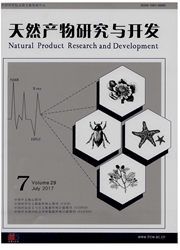

 中文摘要:
中文摘要:
为探讨天麻成分对羟基苯甲醛的抗血小板聚集作用,本实验以二磷酸腺苷(ADP)、花生四烯酸(AA)、血小板活化因子(PAF)为诱导剂,探讨了对羟基苯甲醛的体外抗血小板聚集活性;采用ADP静脉注射致小鼠肺栓塞方法以及下腔静脉结扎致大鼠静脉血栓方法,考察了对羟基苯甲醛的体内抗血小板聚集活性;并对经口给药的对羟基苯甲醛的急性毒性进行了检测。结果表明,天麻成分对羟基苯甲醛对ADP诱导的家兔体外血小板聚集有明显的对抗作用,其半数抑制率(50%inhibitory concentration,IC50)为2mmol/L,对PAF诱导的家兔体外血小板聚集无明显影响;天麻成分对羟基苯甲醛能明显降低小鼠肺栓塞死亡率,并显著对抗大鼠下腔静脉血栓的形成。说明天麻成分对羟基苯甲醛在体外、体内均具有显著的抗血小板聚集活性。急性毒性研究结果表明天麻成分对羟基苯甲醛经口给药的小鼠半数致死量(lethal dose 50,LD50)为1.23g/kg。
 英文摘要:
英文摘要:
This study was to investigate the anti-platelet aggregation function of 4-HBAL extracted from C, astrodia elata Blume. ADP, AA, PAF were used as inducers to study the anti-platelet aggregation function of 4-HBAL in vitro. Pulmonary embolism induced by ADP intravenous injection method and venous thrombosis caused by inferior vena eava ligation method were used to evaluate the anti-platelet aggregation function in vivo. At the same time, the acute toxicity of 4- HBAL given through the mouth was detected. The result showed that 4-HBAL had a significant anti-platelet aggregation function in vitro and in vivo. It could significantly inhibit the platelet aggregation induced by ADP in vitro, and the IC50 was 2 mmol/L. It had no obvious effect on platelet aggregation induced by PAF in vitro. 4-HBAL could obviously decrease the mortality of mice pulmonary embolism and significantly inhibit the thrombosis of rat inferior vena cava. The acute toxicity test showed that LDso of 4-HBAL given through the mouth was 1.23 g/kg.
 同期刊论文项目
同期刊论文项目
 同项目期刊论文
同项目期刊论文
 期刊信息
期刊信息
